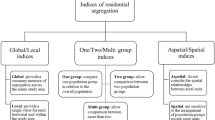Abstract
Spatio-temporal data are common in practice. Existing methods for analyzing such data often employ parametric modelling with different sets of model assumptions. However, spatio-temporal data in practice often have complicated structures, including complex spatial and temporal data variation, latent spatio-temporal data correlation, and unknown data distribution. Because such data structures reflect the complicated impact of confounding variables, such as weather, demographic variables, life styles, and other cultural and environmental factors, they are usually too complicated to describe by parametric models. In this paper, we suggest a general modelling framework for estimating the mean and covariance functions of spatio-temporal data using a three-step local smoothing procedure. The suggested method can well accommodate the complicated structure of real spatio-temporal data. Under some regularity conditions, the consistency of the proposed estimators is established. Both simulation studies and a real-data application show that our proposed method could work well in practice.




Similar content being viewed by others
References
Altman, N. S. (1990). Kernel smoothing of data with correlated errors. Journal of the American Statistical Association, 85, 749–759.
Brabanter, K. D., Brabanter, J. D., Suykens, J. A. K., De Moor, B. (2011). Kernel regression in the presence of correlated errors. Journal of Machine Learning Research, 12, 1955–1976.
Bradley, J. R., Holan, S. H., Wikle, C. K. (2015). Multivariate spatio-temporal models for high-dimensional areal data with application to longitudinal employer-household dynamics. The Annals of Applied Statistics, 9, 1761–1791.
Choi, I., Li, B., Wang, X. (2013). Nonparametric estimation of spatial and space-time covariance function. Journal of Agricultural, Biological, and Environmental Statistics, 18, 611–630.
Cressie, N., Huang, H.-C. (1999). Classes of nonseparable, spatio-temporal stationary covariance functions. Journal of the American Statistical Association, 94, 1330–1340.
Cressie, N., Wikle, C. (2011). Statistics for Spatio-Temporal Data. New York: Wiley.
Dahlaus, R. (1997). Fitting time series models to nonstationary processes. Annals of Statistics, 25, 1–37.
Datta, A., Banerjee, S., Finley, A. O., Hamm, N. A., Schaap, M. (2016). Nonseparable dynamic nearest-neighbor Gaussian process models for large spatio-temporal data with an application to particulate matter analysis. The Annals of Applied Statistics, 10, 1286–1316.
Diggle, P. J., Moraga, P., Rowlingson, B., Taylor, B. M. (2013). Spatial and spatio-temporal log-Gaussian Cox processes: extending the geostatistical paradigm. Statistical Science, 28, 542–563.
Epanechnikov, V. A. (1969). Non-parametric estimation of a multivariate probability density. Theory of Probability and its Applications, 14, 153–158.
Fonseca, T. C. O., Steel, M. F. J. (2011). Non-Gaussian spatiotemporal modelling through scale mixing. Biometrika, 98, 761–774.
Hall, P., Lahiri, S. N., Polzehl, J. (1995). On bandwidth choice in nonparametric regression with both short- and long-range dependent errors. The Annals of Statistics, 23, 1921–1936.
Heuvelink, G. B. M., Griffith, D. A. (2010). Space-time geostatistics for geography: a case study of radiation monitoring across parts of Germany. Geographical Analysis, 42, 161–179.
Higham, N. J. (1998). Computing a nearest symmetric positive semidefinite matrix. Linear Algebra and its Applications, 103, 103–118.
Kafadar, K. (1996). Smoothing geographical data, particularly rates of disease. Statistics in Medicine, 15, 2539–2560.
Liang, K. Y., Zeger, S. L. (1986). Longitudinal data analysis using generalized linear models. Biometrika, 73, 13–22.
Lindström, J., Szpiro, A., Sampson, P.D., Bergen, S., Sheppard, L. (2015), “Spatiotemporal: an R package for spatio-temporal modelling of air-pollution,” https://cran.rproject.org/web/packages/SpatioTemporal/index.html.
Møller, J., Syversveen, A. R., Waagepetersen, R. P. (1998). Log-gaussian cox processes. Scandinavian Journal of Statistics, 25, 451–482.
Opsomer, J., Wang, Y., Yang, Y. (2001). Nonparametric regressin with correlated errors. Statistical Science, 16, 134–153.
Qiu, P. (2005). Image Processing and Jump Regression Analysis. New York: John Wiley.
Robinson, P. M. (1989). Nonparametric estimation of time-varying parameters (pp. 253–264). Statistical Analysis and Forecasting of Economic Structural Change, Berlin: Springer.
Shand, L., Li, B. (2017). Modeling nonstationarity in space and time. Biometrics, 73, 759–768.
Stroud, J. R., Müller, P., Sansó, B. (2001). Dynamic models for spatiotemporal data. Journal of the Royal Statistical Society: Series B, 63, 673–689.
Taylor, B. M., Davies, T. M., Rowlingson, B. S., Diggle, P. J. (2015). Bayesian inference and data augmentation schemes for spatial, spatiotemporal and multivariate log-Gaussian Cox processes in R. Journal of Statistical Software, 63, 1–48.
Vogt, M., Linton, O. (2014). Nonparametric estimation of a periodic sequence in the presence of a smooth trend. Biometrika, 101, 121–140.
Wikle, C. K., Hooten, M. B. (2010). A general science-based framework for dynamical spatio-temporal models. Test, 19, 417–451.
Wikle, C. K., Zammit-Mangion, A., Cressie, N. (2019). Spatio-Temporal Statistics with R. Boca Raton, FL: Chapman Hall/CRC.
Yang, K., Qiu, P. (2018). Spatiotemporal incidence rate data analysis by nonparametric regression. Statistics in Medicine, 37, 2094–2107.
Yang, K., Qiu, P. (2019). Nonparametric estimation of the spatio-temporal covariance structure. Statistics in Medicine, 38, 4555–4565.
Acknowledgements
The authors would like to thank the editor, the associate editor, and two anonymous referees for their constructive comments and suggestions, which improved the quality of the paper greatly. This research was supported in part by the NSF Grant DMS-1914639 in USA.
Author information
Authors and Affiliations
Corresponding author
Additional information
Publisher's Note
Springer Nature remains neutral with regard to jurisdictional claims in published maps and institutional affiliations.
Supplementary Information
Below is the link to the electronic supplementary material.
About this article
Cite this article
Yang, K., Qiu, P. A three-step local smoothing approach for estimating the mean and covariance functions of spatio-temporal Data. Ann Inst Stat Math 74, 49–68 (2022). https://doi.org/10.1007/s10463-021-00787-2
Received:
Revised:
Accepted:
Published:
Issue Date:
DOI: https://doi.org/10.1007/s10463-021-00787-2




